
Charles John Huffam Dickens was an English writer and social critic who created some of the world's best-known fictional characters and is regarded by many as the greatest novelist of the Victorian era. His works enjoyed unprecedented popularity during his lifetime and, by the 20th century, critics and scholars had recognised him as a literary genius. His novels and short stories are widely read today.
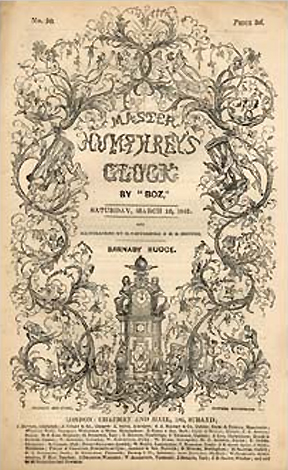
The Old Curiosity Shop is one of two novels which Charles Dickens published along with short stories in his weekly serial Master Humphrey's Clock, from 1840 to 1841. It was so popular that New York readers stormed the wharf when the ship bearing the final instalment arrived in 1841.
Sentimentality originally indicated the reliance on feelings as a guide to truth, but in current usage the term commonly connotes a reliance on shallow, uncomplicated emotions at the expense of reason.

Tong is a village and civil parish in Shropshire, also bordering Staffordshire in England. It is located between the towns of Shifnal, Newport and Brewood. It is near junction 3 of the M54 motorway and A41 road. The population of the village which was included in the civil parish at the 2011 census was 243. The village is also near to Weston Park and the village of Weston-under-Lizard.
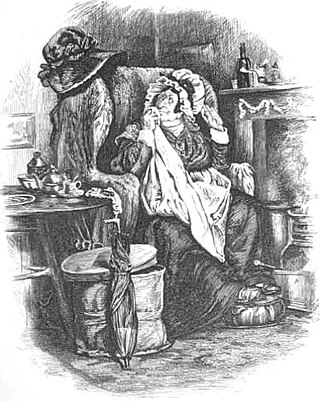
Sarah or Sairey Gamp, Mrs. Gamp as she is more commonly known, is a nurse in the novel Martin Chuzzlewit by Charles Dickens, first published as a serial in 1843–1844.

Sampson Brass is a fictional character in the 1841 novel The Old Curiosity Shop by Charles Dickens. He is a corrupt attorney who affects feeling for his clients, whom he then cheats. Among his clients is the villainous Daniel Quilp, the novel's antagonist. From Bevis Marks in the city of London, he assists Quilp in fraudulently gaining possession of Nell's grandfather's house, plots against Kit Nubbles, and hires and then dismisses Dick Swiveller.
Little Nell may refer to:
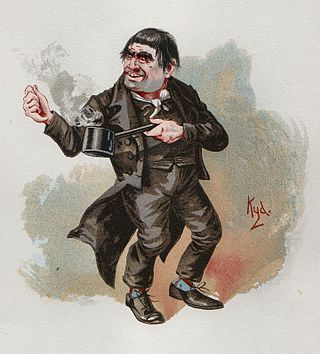
Daniel Quilp is one of the main antagonists in the novel The Old Curiosity Shop by Charles Dickens, written in 1840. Quilp is a vicious, ill-tempered and grotesque dwarf and is the villain of the story. Quilp is as near as Dickens ever came to creating a monster. Actors who have portrayed him include Hay Petrie, Anthony Newley, Patrick Troughton, Trevor Peacock, and Toby Jones.

Blaze is a novel by American writer Stephen King, published under the pseudonym of Richard Bachman. King announced on his website that he "found it" in an attic. As stated in the afterword of Different Seasons, it was written before Carrie. King offered the original draft of the novel to his Doubleday publishers at the same time as 'Salem's Lot; the latter was chosen to be his second novel and Blaze became a "trunk novel." King rewrote the manuscript, editing out much of what he perceived as over-sentimentality in the original text, and offered the book for publication in 2007. The book also contains "Memory", a short story that was first published in 2006 and which King has since worked into Duma Key.

The Old Curiosity Shop is a British television film adapted from the Charles Dickens's 1841 novel The Old Curiosity Shop. It stars Irish actress Sophie Vavasseur as Nell Trent, with Derek Jacobi as her grandfather, Toby Jones as Quilp and George MacKay as Nell's friend, Kit. It was broadcast on 26 December 2007 on ITV. The adaptation is in general very faithful to the novel. The most significant changes are the removal of the Garlands and their household and the identity of the Single Gentleman who is changed from Grandfather's brother to his estranged son and Nell's father.
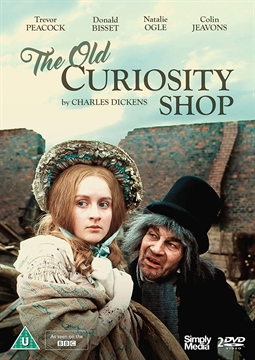
The Old Curiosity Shop is a nine part 1979 BBC TV series based on the 1841 novel by Charles Dickens. It was directed by Julian Amyes, and adapted by William Trevor.
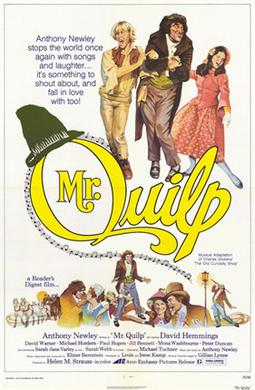
Mister Quilp is a 1975 British musical film directed by Michael Tuchner and starring Anthony Newley, David Hemmings and Jill Bennett. It is based on the 1841 novel The Old Curiosity Shop by Charles Dickens, under which name it was also released.

The Old Curiosity Shop is a 1934 British drama film directed by Thomas Bentley and starring Elaine Benson, Ben Webster and Hay Petrie. It is an adaptation of Charles Dickens' 1841 novel The Old Curiosity Shop.
The Old Curiosity Shop is a 1921 British silent drama film directed by Thomas Bentley and starring Mabel Poulton, William Lugg and Hugh E. Wright. It is based on the 1841 novel The Old Curiosity Shop by Charles Dickens. Bentley remade the novel as a sound film in 1934.
The Old Curiosity Shop is a 1914 British silent drama film directed by Thomas Bentley and starring Mai Deacon, Warwick Buckland and Alma Taylor. It was based on the 1841 novel The Old Curiosity Shop by Charles Dickens, and was the first of three film adaptations of the story by Bentley. It was made by the Hepworth Company, the leading British film studio before the First World War.
The Old Curiosity Shop is a 1984 Australian animated film based on the 1841 novel by Charles Dickens about a young girl (Nell) who lives with her grandfather in a shop, and what happens after they are evicted from the shop by Quilp, a moneylender. It was made by Burbank Films who produced a number of animated films based on classic novels. Their slate cost an estimated $11 million. The Dickens films sold to 20th Century Fox in the US and to the Seven Network in Australia.
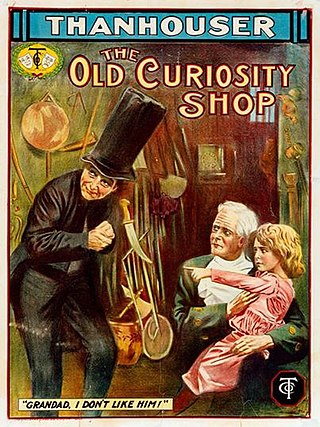
The Old Curiosity Shop is a 1911 American silent short drama film produced by the Thanhouser Company. The film is an adaptation of the 1841 novel The Old Curiosity Shop by Charles Dickens that was limited to the time constrictions of the single reel format. The film focuses on the grandfather who gambles into poverty and the consequences which eventually claim the life of Little Nell. Its survival and attribution as a Thanhouser film was noted by Kamilla Elliott in her 2003 book Rethinking the Novel/Film Debate under the title Little Nell. In 2012, the work was confirmed to be a Thanhouser production at the Pordenone Silent Film Festival. The identification of the film as Little Nell arose due to head of the film having been lost.

Mary Scott Hogarth was the sister of Catherine Dickens and the sister-in-law of Charles Dickens. Hogarth first met Charles Dickens at age 14, and after Dickens married Hogarth's sister Catherine, Mary lived with the couple for a year. Hogarth died suddenly in 1837, which caused Dickens to miss the publication dates for two novels: The Pickwick Papers and Oliver Twist. Hogarth later became the inspiration for a number of characters in Dickens novels, including Rose Maylie in Oliver Twist and Little Nell in The Old Curiosity Shop. Charles and Catherine Dickens' first daughter was named Mary in her memory.

Richard "Dick" Swiveller is a fictional character in the 1841 novel The Old Curiosity Shop by Charles Dickens. Initially a comical accessory to the antagonists in the novel, he undergoes a transformation, becoming a key helpmate bridging the depiction of the main characters that are either mostly villainous or goodly in nature.


















